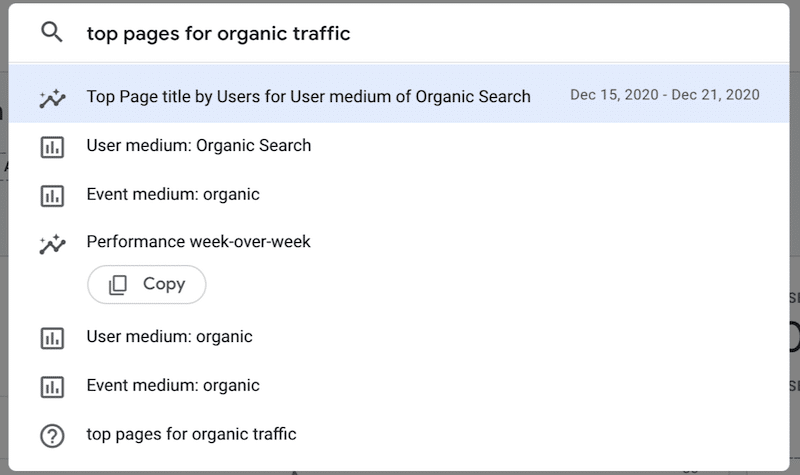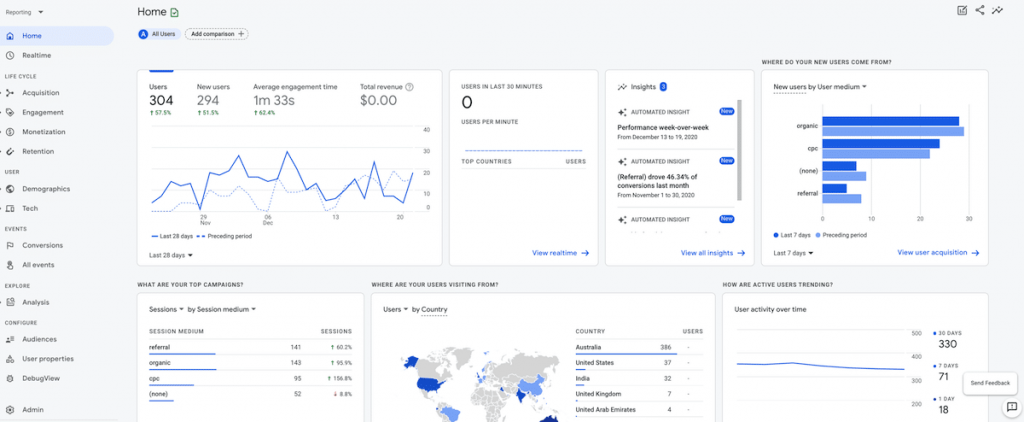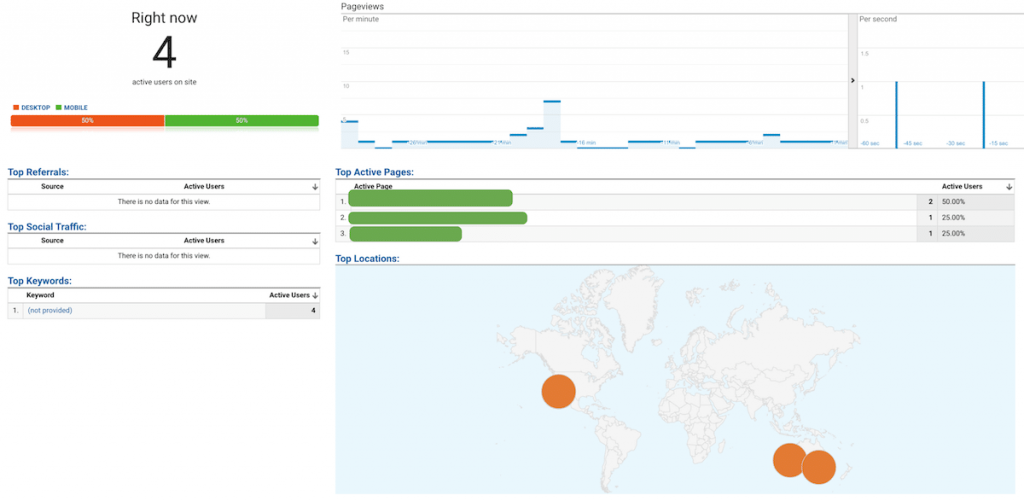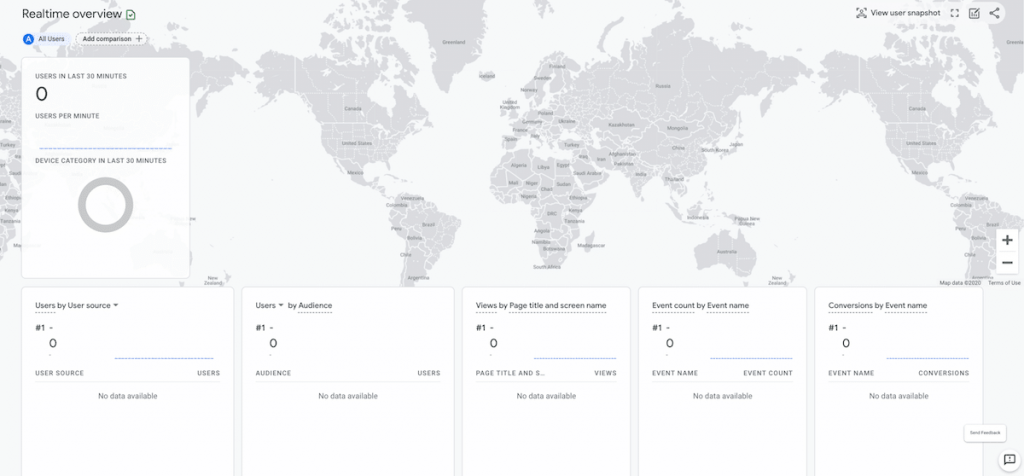Google launched Google Analytics 4 (GA4) on 14 October 2020, the next evolution of Google Analytics.
This article has been updated as of April 2023 to provide more up to date information.
We’ve discussed the importance of using Google Analytics and how you can use it to help optimise your website, and GA4 helps you go one step further!
On 16 March 2022, Google announced that Universal Analytics will no longer collect data as of 1 July 2023. This means that if businesses or brands want historical data in their new Google Analytics reports through GA4, they should switch over now.
GA4 is the default experience for new Analytics users. For existing users, Google invites users to upgrade to GA4 by creating a new property to run parallel with Universal Analytics (the one you’re currently using until the end date of this old platform).
Read on to discover a few new features available on GA4 and how they can help you develop and improve your website.
1. Brand new user settings and interface
Universal Analytics features three types of data settings, namely Account, Property and View. GA4 features only two, which are Account and Property.
This new version of Google Analytics also defines certain elements a bit differently compared to previous versions.
One of the reasons for this change is that Google is preparing for a world where users will continue to opt out of cookies. In Google Analytics case, first-party cookies.
A cookie is a piece of code (Javascript) that is stored on a web browser to tell tools like Google whether you have been to the site before and some of your demographics.
Since Apple changed the game with its tracking consent tool, Google Chrome has finally said that it will launch cookie consent around July 2023 which is expected for the removal of third-party cookies. These cookies are already banned on Safari and Firefox, which track users across multiple sites.
Although the removal of third-party cookies does not impact your Google Analytics tracking, it’s important to note the challenges Google and us marketers will face with fewer data points. Hence, why tracking what is happening on your website and using that as part of your remarketing is more important than before. It also highlights a growing trend around users wanting consent for tracking overall.
2. Changes to goals and eCommerce tracking
Goals are no more in GA4
Goals have been replaced with combining the events feature, and then you have conversions separate to this for your eCommerce like tracking or actions you decide to be marked as a conversion manually from the events dashboard.
Events – which are user interactions that include page views, clicks, or interactions – no longer require customised code all the time for on-site tracking.
What used to be known as Dimensions are now known as Parameters. These are essentially the small details that provide content to a website user action or event.
In Universal Analytics, events were limited by categories such as event category, action, or label. Now with this new setup users can bring in a whole lot more information or attributes with every event to further power their insights.
Essentially, there are now four types of events:
- Automatic events: events already tagged for you and available in the platform.
- Enhanced events: we will explore this in point 6, but essentially they are auto-tagged actions you can toggle on or off.
- Recommended events: events named for you by Google with specific attributes, but are not automatically tracked or on.
- Custom events: very techy manual configuration and should only be used if the event is not available in the other three options.
eCommerce tracking is harder at the moment
The hardest item to swallow at the moment for transitioning to the platform is it’s a bit difficult to get eCommerce data manually.
For users familiar with Universal Analytics or a plugin, it is a lot easier to connect your sales information to that tool in a few clicks.
There are some exceptions now that platforms have prepared for the change.
Squarespace supports the G-ID (Google tag) and once added will automatically track eCommerce variables for you. If you use the scheduling tool Acuity, you can also add your tag there.
Shopify has an eCommerce integration with the Google channel app.
WordPress and Magento rely on plugins to achieve eCommerce data.
eCommerce reporting is also now known as Monetisation, and features new tags for corresponding actions that are still pretty common sense. For example, what was “promoView” is now “view_promotion”.
Understanding how to use GA4 will definitely take some getting used to, and Google themselves have pointed out that it’s better to adjust how you collect your data based on the GA4 model rather than trying to translate your existing Analytics approach to GA4.
3. New search bar
The newly optimised search function on GA4 builds on Google’s AI (also known as artificial intelligence or machine learning).
The search bar features towards the top left of your screen after your Google Analytics 4 Account/Property name.

You can search for:
- Instant answers
You can now use natural language to find immediate answers to your queries, such as “conversions last week from Australia” and see the answer immediately, with an option to click on results for further insight. This is a new feature and several questions will take time for the tool to evolve and collect. Be direct in your questions as best as possible.
- Reports, admin pages, or insights
For reports, typing the name of a report or a keyword related to a report will get you a list of reports that include them. You can also search for comparative date ranges. For example, “page views last month compared to last year” returns reports with the Page Views or the previous month compared to the same month a year ago.
You can also navigate to pages in Analytics Admin and discover relevant Insights the same way.
- Account or property configuration
You can search for terms like Account ID, Property ID, or Measurement ID without having to navigate through Analytics to find them (trust us, this can save you a lot of time in the long run).
- Help content
The new search function can be used to find specific articles to help troubleshoot issues or navigate Google Analytics 4.
We have noticed that Google has also launched a new section called Insights on the main dashboard in March 2022, which is going to feature some of this information.
4. Real time reports
The real time reports are continually updated, with new hits reported just seconds after they happen.
You can see how many users are on your site right now, and what pages they’re interacting with. Real time reports do feature in Universal Analytics but have further evolved in GA4 with a focus on what events your visitors are doing.
How do real time reports help you? Among other things, it can allow you to:
- See if new or updated content is being viewed
- Monitor whether a one-day promotion is driving traffic to your site, and which pages the users are actually viewing
- Check the immediate impact that a social post is having on your website traffic
- Verify that the tracking code is working on your site or app
- Check that events (goals) are being completed whenever you test changes to your site
Universal Analytics Real Time Report
Google Analytics 4 Real Time Report
5. Access to Explorations
A powerful way to get actionable insights on your users, Analysis Hub (now called Explorations) was only available in 360 but is now available to everyone. Explorations is an excellent tool that allows you to discover insights, including those from Google Ads, and then turn them into actions.
You can configure it in a way that is helpful to you, removing and adding dimensions and metrics quickly and easily. Once you’ve discovered data sets that are important or could have a potential impact on your business, you can export them to use in other tools.
Note: The data retention setting limits how long data is held for these reports. The default is 2 months but you can change it up to 14 months.
6. Enhanced measurement without additional coding
One of the most exciting new features in GA4 is called “enhanced measurement,” which automatically tracks file downloads, outbound clicks, video interactions for YouTube videos, site search, and 90% scroll events via the base GA4 tag.
In 2022, Google also introduced form interactions which is meant to measure when someone starts and submits a form on your website. Some sites have had trouble with this. So like any event, make sure to test it before relying on its data.
The Scroll event may also experience issues on some headless content management system sites.
You can simply turn on or off enhanced measurement from the GA4 interface; No additional code or tagging is required.
To do this go to Admin > Data Streams > Select your website > Ensure the toggle is blue (on) position. You can also decide to turn on or off some of the events by clicking the gear icon and using the on and off blue toggle switches.

By adding these new events Google is moving away from the original definition of Bounce Rate and has introduced a new metric called Engaged Sessions. This is welcome news given bounce rate is often lost in its context as it is often just based on a single hit to a website i.e. when someone loads or reloads a page as opposed to knowing what other actions people take on a website.
7. New DebugView tool to track events
Tracking down a bug on your website tracking can be a painstaking task even for the most experienced and tech-savvy folks!
The new debug tool on GA4 can track and validate your Analytics configuration during the development stage so you can avoid nasty surprises.
More importantly, it’s a great way to identify issues when they happen.
If you have used Google Tag Manager, it’s a similar experience and hints to Google almost trying to entice people to use that platform to create or manage their event tracking.
8. Admin section simplified and app data combined
Most settings (now 2 layers) live under property and have been simplified compared to the current setup that has three layers.
Data streams let you bring in things like your app data. So if you have an app, you get even greater insights and a clearer story to tell for your users.
Previously, you’d need to set up analytics for your website and then your app. Now you can see the experience in one platform and help to reduce retargeting to those who have already converted or done certain actions in your app environment.
9. Google signals help with personalisation
When you activate Google signals on GA4, you’ll be able to perform cross-platform personalisation for your website for users that have Ads Personalization switched on.
This type of personalisation can aid in cross-platform reporting, remarketing, and advertising. There are existing tools in Universal Analytics that do this, but there are a few differences in the use of Google signals using GA4.
Google Signals will provide you with demographic information such as age and gender. However, if your site receives less than 500 users on average per day – some of your reports will be sampled to protect users’ privacy.
10. More varied definitions of user engagement
A visitor is automatically labelled as “engaged” if they spend longer than 10 seconds on the site, view 2 or more pages/screens, or complete a conversion event.
There is also a new scroll depth measurement for enhanced engagement which is exciting as it’s more than “average time on page” in terms of helpfulness.
This data coupled with insights from a heatmap like hotjar can allow you to better understand how your content is performing or converting.
Is it time for you to use Google Analytics 4?
Short answer: yes!
Long answer: while GA4 is bound to be a useful tool for your website development in the long run, it’s still new, which means there won’t be any historical data. So if you are still using Universal Analytics, we recommend that you use both at the same time. Also, because GA4 is still evolving and many features are yet to come.
Follow this handy resource for a guide on how to set up the tag.
Are you feeling overwhelmed with Google Analytics 4? Get in touch with us so we can help you discover how to use GA4 for your website and help your business grow!















